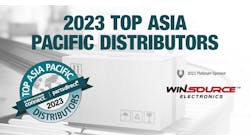Download this article in PDF format.
Business is booming for electronics distributors as industries worldwide emerge from the COVID-19 pandemic and get back to business. And while supply chain interruptions, extended order lead times, labor shortages and lingering pandemic impacts continue to affect the way organizations do business, the electronics distributors we interviewed for this article concur on at least one thing: Business is brisk right now, and there’s no sign of a slowdown in sight.
“We’ve had record-breaking bookings and sales in Q1, along with a sustained flow of activity that has extended into the second quarter of the year,” says Frank Flynn, president at Sager Electronics. “This has put significant of demands on our teams, and they are responding very well.” Going into the second quarter of the year, Flynn says he was pleased to see the momentum continuing. “First quarter was great, and we were wondering if things might begin to plateau, but for now it’s just continuing to move along at a similar pace.”
Digi-Key Electronics appears to be riding a similar wave in 2021. “As the guy who runs sales and marketing at Digi-Key, I’d say it’s been a wonderful year so far,” says Jim Ricciardelli, EVP of digital business. “The growth in our industry has been ‘crazy good.’” So crazy good, in fact, that Digi-Key posted sales growth of 42% during the first quarter, compared to the same period in 2020. “So far,” Ricciardelli adds, “April and May are outpacing that.”
At TTI Americas, President Don Akery says the distributor is seeing “demand from all segments,” including commercial air travel and oil & gas. “If you look at business compared to where it was in 2020, it’s up substantially this year,” says Akery. “We’ve been watching daily run rates month-over-month both from a booking and a shipping standpoint, and those numbers are 30% and almost 20%, respectively.”
2021 Top 50 Electronics Distributors List >>
Some Parts are Hard to Come By
Distributors may be posting impressive year-over-year sales gains right now, but most of them are also grappling with unprecedented challenges in the current marketplace. Already constrained leading up to the pandemic, for example, component availability—and particularly for anything semiconductor-related—has become a focal point for electronics manufacturers and distributors this year.
In a recent EndeavorB2B Webinar, IHS Markit’s Greg Woods discussed how global lockdowns significantly impacted consumer spending habits and drove up demand for game consoles, TVs, smartphones and other consumer electronics. Wafer and die production capacity at fab plants geared up to meet that demand right at a time when the automotive industry decided to start an earlier-than-expected 2020 rebound. Orders for semiconductors outpaced die availability, Woods says, and semiconductor ordering lead times began to lengthen out starting in early-December.
The situation hasn’t improved much since that point, with some lead times now extending out by seven months (or more). Digging down into the period between May 2020 and April 2021, Woods says manufacturers’ lead times increased for 83% of semiconductor parts during that time.
Parts in particularly high demand and short supply during this period were oscillators, uPs/uCs/peripheral ICs, programmable logic ICs, memory ICs, transistors, diodes and consumer ICs. Between May 2020 and April 2021, for example, the average lead time for oscillators increased to 28 weeks (from seven weeks, while uPs/uCs/peripheral ICs saw their lead times extend to 30 weeks (from 11).
To distributors and other buyers trying to navigate the semiconductor shortage, IHS Markit recommends buying well in advance and carrying more inventory of critical components. Procurement should establish contracts with distributors, it adds, while conducting daily monitoring of critical component lead times.
To manage component end of life (EOL) and obsolescence during this inventory-constrained period, IHS Markit recommends selecting parts for new designs with cross references from multiple manufacturers wherever possible, and tells companies to monitor parts daily for changes to product status and any change notifications. “Understand part types with short life cycles,” it adds, “and conduct regular reviews of products with longer life cycles to best understand risks.”
Holding their Own Through the Turmoil
Going into 2020, it was anyone’s guess as to how the year would go for Source Today’s Top 50 Distributors. The U.S. economy appeared to be reaching the bitter end of a long, positive economic run, a contentious presidential election season was about to get underway and some markets were beginning to signal a potential slowdown. What we couldn’t have predicted was a global, far-reaching COVID-19 pandemic that would take a deadly toll on human life while also bringing some entire industries to their knees.
The pandemic would eventually blanket the business world for the entire year, with some industries coming out winners, others recording massive losses and still others winding up somewhere in the middle. In looking at the SourceToday 2021 Top 50 Distributors list, the electronics distribution sector appears to have held its own through the darkest days of the pandemic, and then rebounded fairly quickly as world economies began their slow trek to recovery.
Combined, the top five distributors on this year’s list posted revenues exceeding $56 billion in 2020, down from a combined $59 billion the prior year. The top two distributors on the list—Arrow and Avnet—both posted losses for the overall year. The next three—Future Electronics, Digi-Key and TTI—all posted gains for the year. The total revenues for the next five entrants—Allied Electronics, Mouser, Smith, Newark and Rutronik —reached nearly $8 billion in 2020, and were mostly even with the prior year. Of the 43 distributors that did report their revenues to Source Today for this year’s chart, their total sales were in excess of $70 trillion.
Taking the Good with the Bad
When any company gets on a growth trajectory, new challenges begin to surface almost as quickly as the emerging opportunities do. This is exactly what’s happening in 2021 as electronics distributors work to balance demand with their own resources during a period where customers can’t place orders or get their stuff fast enough.
"While we're trying to manage the influx of sales and booking activity, we’re managing all the expedites that are coming along with it,” says Flynn. “Concurrently, manufacturers are wrestling with a lot of raw material shortages and capacity issues that have really extended lead times.”
To top it off, Flynn says those manufacturers are beginning to increase their prices as they deal with their own set of challenges, mostly related to rising costs of raw materials and transportation. Add the container shortage and lack of truck drivers to the mix, and it becomes somewhat of a “perfect storm” of challenges for distributors and their suppliers to contend with.
As they continue to navigate these complexities, distributors are also exploring new market opportunities, moving into new market segments and ramping up their existing offerings. Sager, for example, is finding good success in the battery pack market, which it invested in several years ago.
As they look for ways to circumvent the semiconductor shortage, customers are also sourcing more subassemblies versus discrete components, according to Flynn, who predicts a strong second half of 2021 propelled by customers that realize long lead times have become the norm.
“We may see some moderation in bookings as we go into the second half, but our backlog is at an all-time high right now,” says Flynn. “We expect sales to continue growing. There are some obvious headwinds out there right now, but we don’t expect them to slow this overall trend. It's just too strong.”
Stocking Up
Coming out of the pandemic-related lockdowns, Mouser Electronics anticipated potential supply chain challenges—and its prediction was dead-on. When those interruptions began happening, the company’s strategy of investing in and maintaining a strong inventory position paid off. “Since we order months in advance of expected demand,” explains Mark Burr-Lonnon, Mouser’s senior VP of global service & EMEA and APAC Business, “we’ve done a good job trying to stay ahead of lead time extensions and product availability issues.”
Now, Burr-Lonnon says the company continues to stock the “widest product selection in the industry and suggest product alternatives if needed.” Even with that approach, the distributor is subject to extended lead times and allocation on some products. As a result, keeping up with demand has become a key challenge. “Some sources are very limited in their component offerings,” says Burr-Lonnon, who is optimistic about the remainder of the year across most markets.
“[While] the pandemic still is impacting manufacturing globally, we are seeing strong signs of growth in all regions—especially with the need for components (due to shortages) and the increase in new design and innovation,” he says. “The use of electronic devices and systems is strong worldwide, and we are still shipping hundreds of thousands of components weekly.”
2021 Top 50 Electronics Distributors List >>
Embracing a Digital Transformation
So far in 2021, Avnet has seen continued growth in the automotive, industrial, consumer, communication and computing segments. It’s also picked up on significant growth in the industrial segment for robotics, factory automation and smart vision applications. “Many of our customers across all vertical markets need efficient power management solutions embedded in their applications,” says Peggy Carrieres, Avnet’s global VP of sales enablement and supplier development.
“What’s more,” Carrieres continues, “as the market becomes more digital, we are seeing traditional B2B companies branch out direct to consumer, enabling companies to reach more of the mass market with different products.” She sees vehicle electrification as a key disruptor in the automotive space, where Avnet is seeing growing requirements for EV battery management and increased infrastructure (i.e., level 3 charging stations) “to support the mass adoption of electric modes of transportation.”
Encouraged by the continued recovery in the Americas and EMEA, both of which saw strong gains during the first quarter of the year, Carrieres says Avnet is also experiencing continued strong performance in Asia. “We recognize uncertainty around the ongoing pandemic remains,” she adds, “but we have a strong foundation and remain positive on delivering on all our recent commitments.”
At Allied Electronics & Automation, President Ken Bradley says he’s seeing more emphasis being placed on digital technologies, automation and the Industrial Internet of Things (IIoT) within the growing industrial market. In addition, he says the number of people receiving digitally enabled medical care continues to grow, as does demand for cloud software that can be used to support remote teams.
Going forward, Bradley expects the distribution segment to continue to face challenges in the supply chain as demand in the electronics industry soars for everything from semiconductors to 5G. He also sees the bonds between distributors and their manufacturer partners becoming stronger than ever in the post-COVID business environment.
“Distributors with the right solutions and capabilities bring new customer opportunities to all manufacturers’ sales and marketing channels via [a] digital presence,” Bradley says. “A distributor’s investment in inventory management and supply chain solutions boosts a manufacturer’s competitiveness within [this] volatile and challenging supply chain environment.”
Bullish on the Future
As they embrace new opportunities, tackle current challenges and future-proof their operations against new disruptions, the resilient distributors that make up the Source Today Top 50 will take the lessons learned from 2020 and apply them for years to come. They’re also adopting new technologies, experimenting with new inventory management techniques, and opening their doors to a wider swath of customers that need their products and services.
All of this is being done in the name of building resilient, agile distributorships that can withstand any shock that’s thrown at them. A sector that’s seen more than its fair share of disruption and competition over the last few decades, distribution is well positioned to thrive in 2021 and beyond.
“The only segment we’re seeing year-over-year reductions in right now is medical, and a lot of that has to with the fact that demand for ventilators and related items isn’t as high as it was at this time in 2020,” says Akery, who expects the rise in transportation and raw material costs to continue over the next few months.
“We’re seeing new price increases almost daily,” Akery says, adding that TTI works to honor its contracts and not change prices until those contracts are up, which isn’t always easy to do when the cost of zinc, copper wire, cable and cold-rolled steel are rising in the double digits. “These are some of the largest price increases we’ve seen in a long time.”
Challenges aside, and with demand expected to stay strong for the remainder of the year and into 2022, Akery is feeling pretty optimistic right about now. “We’re pretty bullish on what the next year-and-a-half will bring.”










